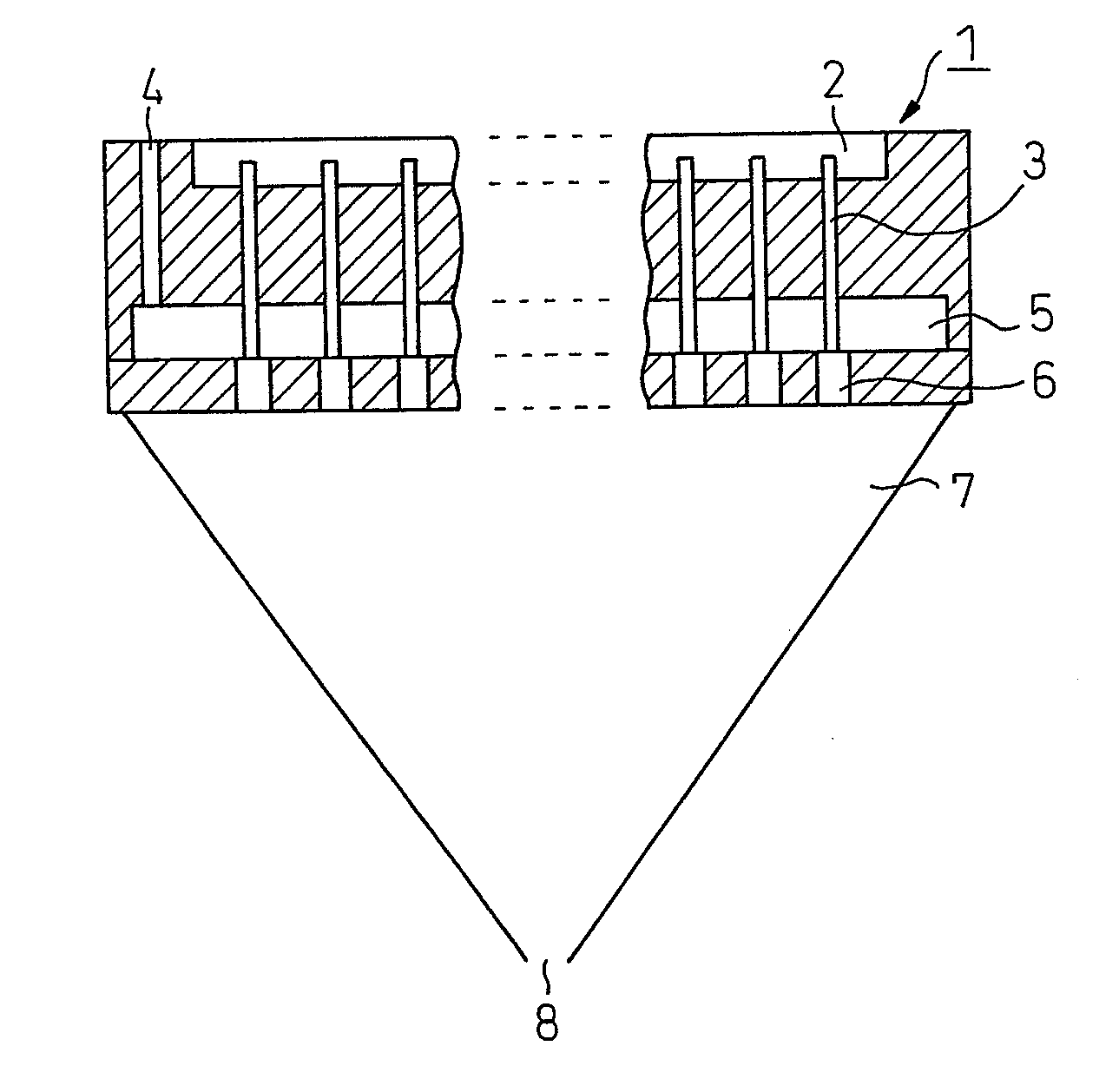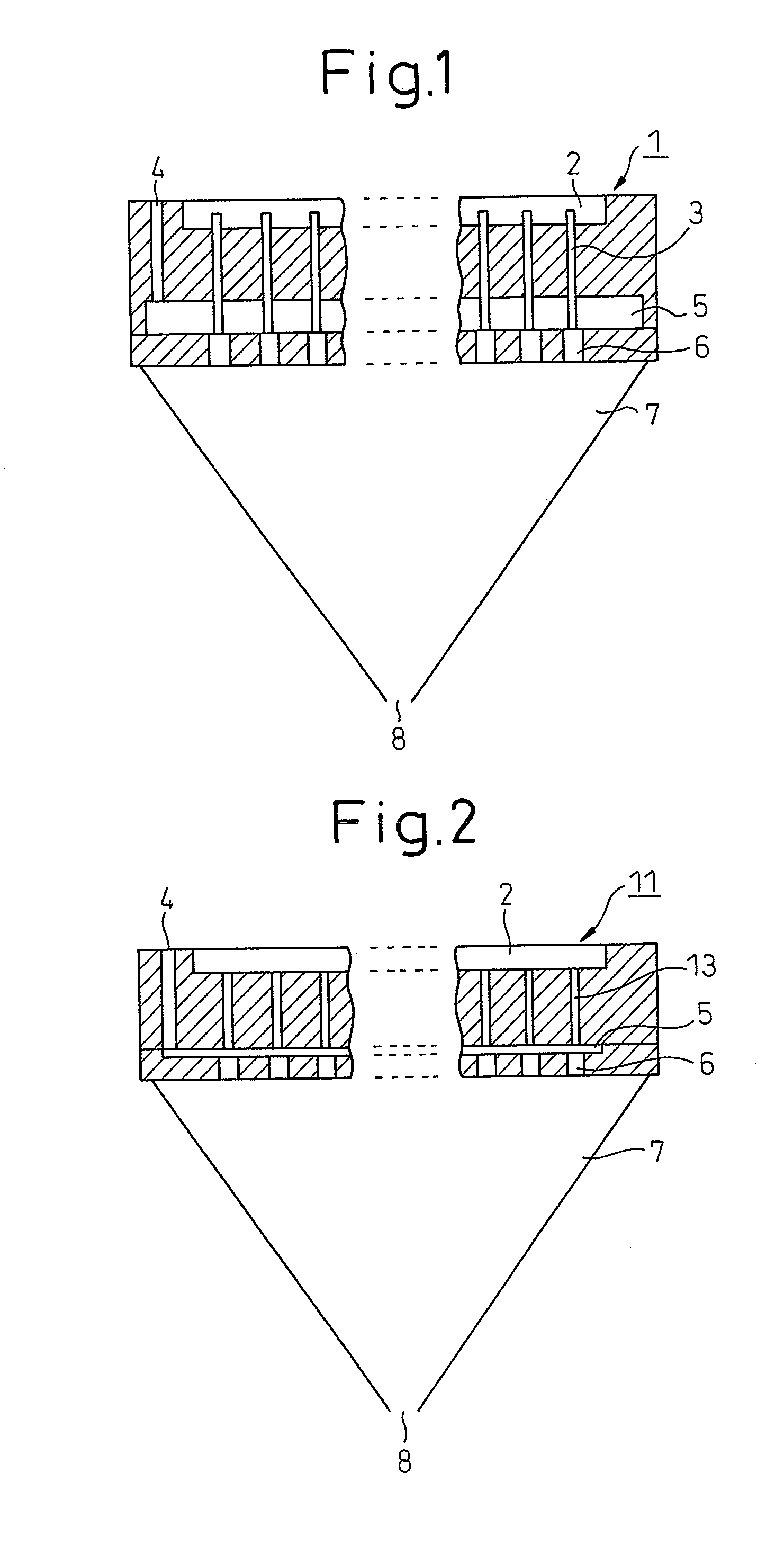Method of producing islands-in-sea type composite spun fiber
a technology of composite yarn and islands, which is applied in the direction of yarn, filament/thread forming, transportation and packaging, etc., can solve the problems of poor stringiness, poor spinning stability, and formation of foreign materials on the face of the spinneret, and achieves easy woven or knitted, high productivity, and easy stacked
- Summary
- Abstract
- Description
- Claims
- Application Information
AI Technical Summary
Benefits of technology
Problems solved by technology
Method used
Image
Examples
example 1
[0056]A poly(ethylene terephthalate) (IV=0.64 dl / g, Tg=70° C., Tm=256° C.) in which diethylene glycol in an amount of 1% by weight based on the total weight of the poly(ethylene terephthalate) was copolymerized was used as island components. A modified poly(ethylene terephthalate) (IV=0.47 dl / g, Tg=54° C., Tm=251° C.) in which a poly(ethylene glycol) (average molecular weight of 4,000) in an amount of 3% by weight based on the total amount of the modified poly(ethylene terephthalate) and 5-sodiosulfoisophthalic acid in an amount of 6% by mole based on the total repeating units thereof were copolymerized was used as a sea component. A spinneret (the same type as in FIG. 1) having the number of island components of 19 was used, and the sea component polymer and the island component polymer in a sea component:island component weight ratio of 50:50 were spun with an injection amount of 0.75 g / min / nozzle at a spinning speed of 500 m / min to give an undrawn islands-in-sea type composite sp...
example 2
[0061]A poly(ethylene terephthalate) (IV=0.64 dl / g, Tg=70° C., Tm=256° C.) in which diethylene glycol in an amount of 1% by weight based on the total weight of the poly(ethylene terephthalate) was copolymerized was used as island components. A modified poly(ethylene terephthalate) (IV=0.41 dl / g, Tg=53° C., Tm=215° C.) in which a poly(ethylene glycol) (average molecular weight of 4,000) in an amount of 3% by weight based on the total weight of the modified poly(ethylene terephthalate) and 5-sodiosulfoisophthalic acid in an amount of 9% by mole based on the total repeating units thereof were copolymerized was used as a sea component. A spinneret (the same type as in FIG. 1) having the number of island components of 1,000 was used, and the sea component polymer and the island component polymer in a sea component:island component weight ratio of 30:70 were spun with an injection amount of 0.75 g / min / nozzle at a spinning speed of 500 m / min to give an undrawn islands-in-sea type composite...
example 3
[0063]A poly(ethylene terephthalate) (IV=0.43 dl / g, Tg=70° C., Tm=256° C.) in which diethylene glycol in an amount of 1% by weight based on the total weight of the poly(ethylene terephthalate) was copolymerized was used as island components. A modified poly(ethylene terephthalate) (IV=0.41 dl / g, Tg=53° C., Tm=215° C.) in which a poly(ethylene glycol) (average molecular weight of 4,000) in an amount of 3% by weight based on the total weight of the modified poly(ethylene terephthalate) and 5-sodiosulfoisophthalic acid in an amount of 9% by mole based on the total repeating units thereof were copolymerized was used as a sea component. A spinneret (the same type as in FIG. 1) having the number of island components of 1,000 was used, and the sea component polymer and the island component polymer in a sea component:island component weight ratio of 50:50 were spun with an injection amount of 0.75 g / min / nozzle at a spinning speed of 500 m / min to give an undrawn islands-in-sea type spun fibe...
PUM
| Property | Measurement | Unit |
|---|---|---|
| diameter | aaaaa | aaaaa |
| temperatures | aaaaa | aaaaa |
| diameter | aaaaa | aaaaa |
Abstract
Description
Claims
Application Information
 Login to View More
Login to View More - R&D
- Intellectual Property
- Life Sciences
- Materials
- Tech Scout
- Unparalleled Data Quality
- Higher Quality Content
- 60% Fewer Hallucinations
Browse by: Latest US Patents, China's latest patents, Technical Efficacy Thesaurus, Application Domain, Technology Topic, Popular Technical Reports.
© 2025 PatSnap. All rights reserved.Legal|Privacy policy|Modern Slavery Act Transparency Statement|Sitemap|About US| Contact US: help@patsnap.com


